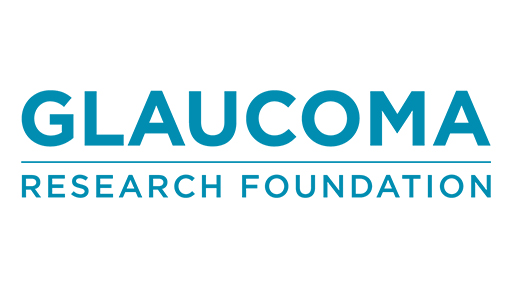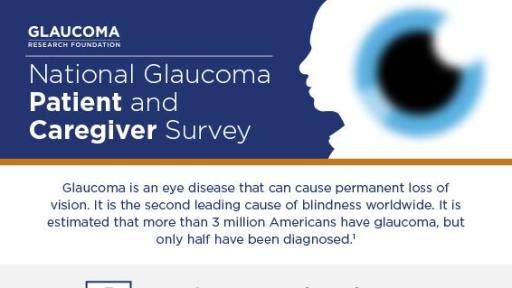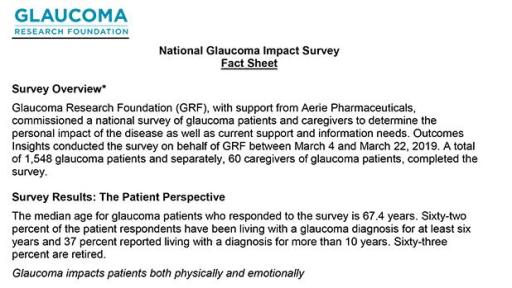National Survey Reveals Glaucoma Has Significant Impact on Patients’ and Caregivers’ Daily Lives and Well-Being
- Findings from survey of 1,608 Americans suggest that while they are determined to manage the disease, many worry about loss of vision and independence
- Only 53 percent of glaucoma patients report achieving and maintaining their intraocular pressure (IOP) goal, the only modifiable risk factor for glaucoma
- 52 percent of caregivers say caring for a person with glaucoma impacts their lives constantly or frequently
- Glaucoma Research Foundation commissioned survey with support from Aerie Pharmaceuticals, Inc.

SAN FRANCISCO, September 5, 2019 – Glaucoma Research Foundation (GRF), a national non-profit organization dedicated to finding a cure for glaucoma, announced results from a national survey designed to assess the impact of glaucoma on patients and caregivers, as well as to identify their information and support needs. Survey findings reveal that glaucoma impacts patients and their caregivers on a daily basis, and that many patients struggle to effectively control their disease.
“The information, support services and treatments available to glaucoma patients have increased markedly in the past several years, but we know anecdotally that patients and caregivers still have difficulty managing the disease, its practical implications and their fears related to it,” said Andrew Iwach, MD, GRF board chair and executive director, Glaucoma Center of San Francisco. “This survey helped us quantify current patient and caregiver experiences so that we can continue finding new ways to reduce the burden of the disease for everyone and to improve patients’ outcomes.”
A total of 1,548 adult glaucoma patients and separately, 60 glaucoma-patient family and friends who serve as caregivers, completed GRF’s National Glaucoma Impact Survey. Overall, findings confirm that glaucoma has a daily impact on the majority of patients and caregivers – not only because of the practical issues caused by medication management and vision loss, but also because it creates anxiety, fear and even depression for many.1
- Almost two-thirds (64 percent) of all patients say the disease impacts their lives on a daily basis. This impact is even more pronounced among African American patients (72 percent).
- Patients worry about losing their vision (76 percent are very or extremely concerned) and their ability to drive (65 percent are very or extremely concerned), as well as other hallmarks of independence (50 percent are very or extremely concerned about their ability to live independently; 37 percent are very or extremely concerned about their ability to care for themselves).
- Younger patients (those under age 65) report being slightly more worried about the disease’s potential impact on all aspects of daily living than their older counterparts, including their ability to drive, participate in activities they enjoy, live independently and care for themselves.
- Younger patients also report feeling angrier (13 percent <65 vs. 8 percent of those age 65-74) and more depressed (22 percent <65 vs. 14 percent of those age 65-74) about their glaucoma than older patients.
- Despite their anxiety and fear, 64 percent of patients say they are determined to take control of their glaucoma.
- Caregivers worry not only about the person they care for losing their vision and independence, but also about the impact of glaucoma on their own lives. More than half of caregivers (52 percent) report that caring for a patient with glaucoma impacts their lives “constantly” or “frequently” and that it is “moderately,” “very” or “extremely” burdensome caring for a glaucoma patient (53 percent).
In addition to the emotional impact of glaucoma, patients report that they have difficulty controlling their disease and are dissatisfied with their prescription eye drops – the most commonly used glaucoma treatment.
- 89 percent of glaucoma patients take eye drops. Patients take an average of three drops per eye, per day to manage their disease.
- 52 percent of those surveyed say that they are “not at all,” “slightly” or only “moderately” satisfied with the drops they use. One-third of patients report that they miss an eye drop dose at least two to three times per month.
- While most patients know their last intraocular pressure (IOP) measurement and their IOP goal (89 and 84 percent, respectively), just 53 percent say they achieve and maintain it. Elevated IOP is the only modifiable risk factor for glaucoma.2
“It is alarming but not surprising that only about half of patients are able to keep their intraocular pressure under control,” said Thomas Brunner, GRF president and CEO. “The glaucoma community is clearly doing a good job educating patients about the importance of IOP, and as the list of available medications and new surgical procedures continues to grow, we will have a greater opportunity to individualize glaucoma therapy and improve outcomes. Now we need to identify and address the remaining, individual barriers to effective disease management and patient engagement so that we can help reduce patients’ anxiety while better protecting their vision.”
Most patients feel well cared for by their glaucoma doctors and are aware of key facts related to the disease. However, survey findings suggest that both patients and caregivers could benefit from more information about new treatment options.
- 90 percent of patients “agree” or “strongly agree” that their eye doctor cares about them and preserving their vision, and 90 percent “agree” or “strongly agree” that they are grateful to their eye doctor for preserving their vision.
- Glaucoma patients are very aware that glaucoma is a progressive disease with no signs or symptoms (82 percent “extremely aware”) and may cause blindness (92 percent “extremely aware”).
- Patients actively seek information about glaucoma treatment, clinical trials, and new treatments, because they anticipate they will need a new treatment in the future.
- 58 percent of patients report that their physicians routinely discuss future treatment options with them. However, only 34 percent of patients say they feel “very” or “extremely” well-informed about new glaucoma treatment options.
- Caregivers similarly report feeling uninformed about new treatment options; 75 percent say that more information would help them.
- When physicians discuss a new treatment option with patients, they are almost twice as likely to discuss surgery vs. adding eye drops or switching eye drops (42 percent vs. 23 percent and 21 percent). Patients say they would strongly prefer receiving a new type of prescription eye drop vs. undergoing surgery if they need a new/different treatment (65 percent vs. 19 percent).
“We are grateful for the opportunity to help GRF and the glaucoma community better understand the current needs of glaucoma patients and their caregivers,” said Richard Lewis, M.D., chief medical officer, Aerie Pharmaceuticals, and a practicing glaucoma specialist. “The results make our shared objectives clear. As the population ages and more people are diagnosed with this disease, the ongoing search for more effective treatments must be accompanied by enhanced support services to reduce the daily burden of living with glaucoma.”
About the National Glaucoma Impact Survey
Glaucoma Research Foundation (GRF), with support from Aerie Pharmaceuticals, commissioned a national survey of glaucoma patients and caregivers to determine the personal impact of the disease as well as current support and information needs. Outcomes Insights conducted the survey on behalf of GRF between March 4 and March 22, 2019. A total of 1,548 glaucoma patients and separately, 60 glaucoma-patient caregivers, completed the survey. All survey participants were age 18 or older. The median age for glaucoma patients who responded to the survey was 67.4 years. The typical caregiver was 60 years old, female and had been caring for someone with glaucoma for 10 years or more.
About Glaucoma
Glaucoma is the second leading cause of blindness in the world, and vision loss from glaucoma is irreversible. Currently there is no cure, and everyone is at risk for developing this blinding disease. It is estimated that by 2040, 111 million people worldwide will have glaucoma.
About Glaucoma Research Foundation
Glaucoma Research Foundation (GRF) is a national non-profit organization dedicated to finding a cure for glaucoma. For more than 40 years, Glaucoma Research Foundation has worked to advance sight-saving research and provide essential educational resources for patients. It funds critical research into glaucoma treatment, vision restoration, and a cure for glaucoma. It is also the leading source of information for glaucoma patients and their families. For more information, visit www.glaucoma.org.
The National Glaucoma Impact Survey was supported by Aerie Pharmaceuticals.
MEDIA CONTACT
Christy Curran
Sam Brown Inc.
(615) 414-8668
[email protected]
1 Patient survey results are generalizable to Americans with glaucoma who met the survey entry criteria. Caregiver results are directional only, i.e., the sample size (n=60) is too small to be generalizable to all glaucoma-patient caregivers in the United States.
2 Coleman AL, Kodjebacheva G. Risk Factors for Glaucoma Needing More Attention. Open Ophthalmol J. 2009; 3: 38–42.



